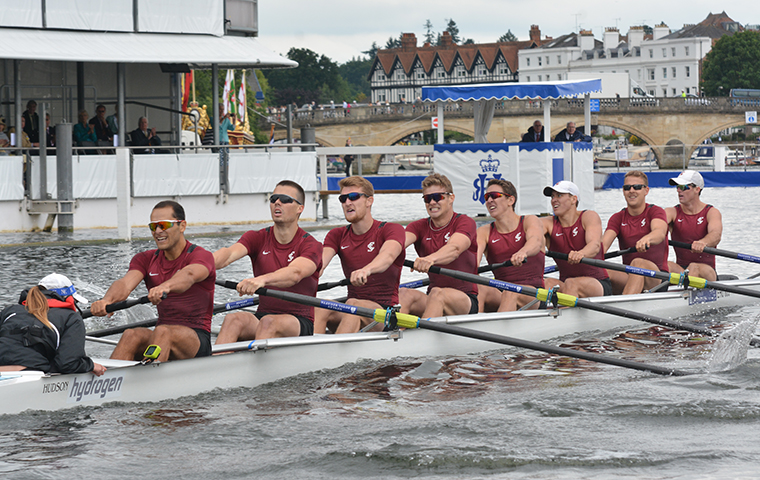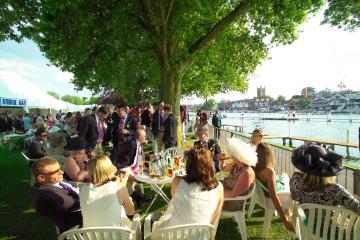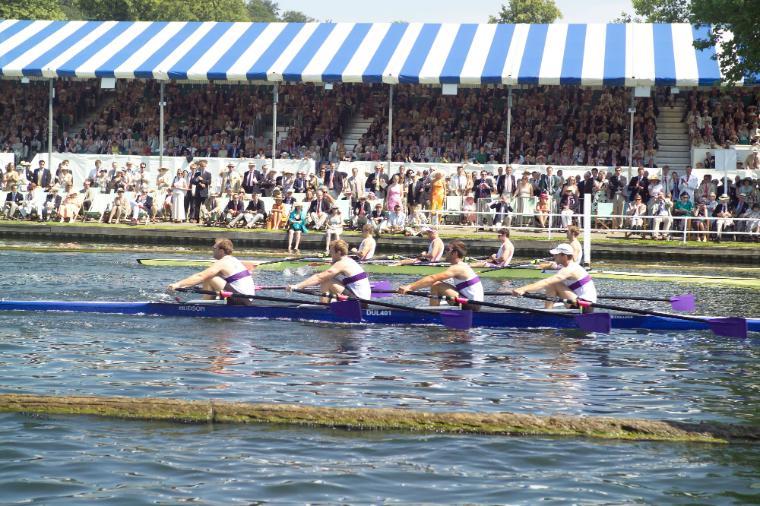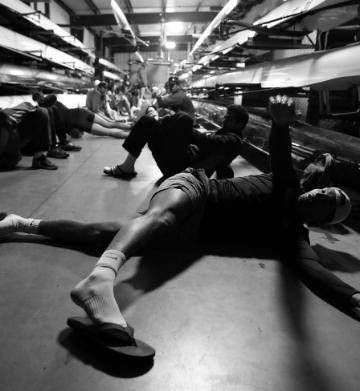
Bronco River Royalty
A quarterfinal finish for men’s crew in the Henley Royal Regatta on the River Thames. Call it the Wimbledon of rowing.
With the waves of the River Thames lapping against the hull of his eight-man shell, Peter Morton ’18 sat at the starting line and could feel the tug of nearly two centuries of rowing history in the current. To his right, a shore of impeccably dressed spectators—men in natty blazers and women in summer dresses and broad-brimmed hats, some of the watchers seated right on river’s edge, feet dangling in the cool water. Farther upriver, thousands more watched from grandstands and tents. To Morton’s left, lush trees that would open up to the historic town of Henley-on-Thames before course’s end, English cottages just yards from the water. Up the river a bit more, a 94-foot burgundy boat with shining gold filigree belonging to the Queen of England.
For Morton and his Santa Clara teammates, it was one of the most important races of their lives. But that’s true for the hundreds of teams who would race. How important? “There are more people watching the Henley Regatta than the Olympics,” Morton says.
Since 1839, the Henley Royal Regatta has been to rowing what the Kentucky Derby is to horse racing and Wimbledon is to tennis. The regatta takes over the town of Henley-on-Thames for five days each summer, this year from June 28 to July 1, bringing the best rowing crews in the world to compete in six events. The Henley featured 577 crews from 15 nations in 2017. For Santa Clara University, this was the first time ever a team rowed in this singular event.
The Henley doesn’t follow tradition. It is tradition. The race itself runs longer than a typical rowing course—2,112 meters, compared to 2,000, which is standard today—because Henley predates any formal rowing organization. Coaches and judges eschew modern shells to ride behind the action in old wooden boats with names like Ulysses and Herakles. Spectators must follow a strict dress code and adhere to a mobile phone ban to be allowed in the steward’s enclosure. If a man takes off his blazer, even in the heat of summer, he will be reminded to put it back on—or be advised to leave. The Henley’s website urges members to remind guests of the rules, “to avoid the possibility of embarrassment.”

The view from Bridge Bar at the Henley Royal Regatta in England. Photo courtesy Henley Royal Regatta
Waiting at the starting line in the second round of the head-to-head bracket June 29, Morton was joined by teammates including James Martino ’17 and coxswain Grace Anne D’Amico ’18—who had joined Martin for years of 6 a.m. practices. Before the start, it was quiet. Martin noticed how narrow the river was with just two lanes—compared to the typical six or seven lanes of boats. The boat from the University of Virginia, favored to win, rested a few feet away. It was a small physical space, but it all felt very big.
“Attention!” the judge yelled. “Go!”
Pond Crossers
The possibility of competing in the Henley was dangled before the Santa Clara men’s rowing team early in the season. Jay Farwell ’94, J.D. ’01 told his team if they won the San Diego Crew Classic, a barometer-type event for the program, held in early April, they might make the trip. The Henley offers a chance for up-and-coming programs to make a name for themselves. By the measure of recent successes, the Broncos are certainly up-and-comers. For the past three years, the team has qualified for the Intercollegiate Rowing Association national championships and finished in the top 25.
But competing in the Henley takes much more than simply deciding to go. It takes planning, finances, and most important, a team capable of competing. For Santa Clara, the endeavor began years ago when Marc Vallancey ’85, a former SCU rower and native of England who now runs a financial consulting firm, put the bug in the ear of Coach Farwell. This fall, the coach began considering the trip more seriously.
Vallancey is Brit and Bronco through and through, and he wanted to bring his alma mater and home country together. When he floated the idea to Farwell, the coach loved it—but there were budget realities to face. That’s where some of the alumni rowers came in. Their financial support for crew made it feasible.
Henley-on-Thames is about an hour’s drive from London. Vallancey helped Farwell plan the trip: travel accommodations, registration, even lodging with a host family who provided meals and secured bikes for the Santa Clara rowers to explore Henley-on-Thames and soak in the festivities. After a practice race Santa Clara won, the team took a boat ride down the river and saw the countryside at a leisurely pace they’re not allowed when racing on the water.

“Everybody is so important there. There are Olympians everywhere,” Morton says. “The world’s No. 1 and No. 2 boats, Germany and New Zealand, raced in the semifinal—not even the final. You’re surrounded by this amazing talent in our sport.”
Just Breathe
Getting an early lead is important in head-to-head rowing in a way it isn’t against bigger fields. Once you jump ahead, the other team can’t see you, and the lead tends to grow. The race against the University of Virginia was not that simple. (Watch the full race here)
Santa Clara jumped out to a boat-length lead early, but Virginia kept inching back within a half-length. “They weren’t letting up and they kept pushing back on us,” Morton says. “We just had to keep going. We could never settle.”
Everybody experiences races differently, Morton says. For some, it’s a blur. For others, they might be able to remember even little details. But post-race, normally everyone experiences wins the same way. You relax, let loose, celebrate. After UVA, it was about recovery. Get back to shore and breathe. “We needed 10 minutes to get our bodies back.”
Morton calls that second-round race against UVA among the toughest they’ve had all year. That includes their 23rd place finish in the IRA national championship in early June.
Parents of the Santa Clara rowers who made the trip to England met the team on the shore, admitting they’d never expected the Broncos to make it to the quarterfinals. With a touch of humor, Morton says, “Thanks, Mom and Dad!”
Santa Clara was the only unranked team to make it to the final eight. In the quarterfinals they fell to the University of California, one of the top teams in the country. But if making a name for the program was the point of the trip, Farwell and his team succeeded.
“There’s no shame in losing to California,” Farwell says. “All of our heads were held high and we were really proud of our effort over there and how we represented the University.”
Built to Last
It’s safe to say that the juniors and seniors on Santa Clara’s rowing team, like Peter Morton, didn’t foresee the Henley Royal Regatta back when they joined the team. Morton chose Santa Clara because the school and program were smaller, and he felt he would have a bigger impact on the team’s success. “But we’ve completely evolved from a small program to starting to feel like a big one,” Morton says. “We’re starting to develop talent and gain some recognition nationwide.”
And internationally.

Early Risers: Members of the SCU men's rowing team stretch before a 6 a.m. practice. Photo by Don Jedlovec
Farwell credits recent success with efforts that go back a few years—with what he calls the best recruiting class in school history. In 2015, led by then-first-year Morton, Thatcher Bouck ’18, Michael Brewer ’18, Nick Cisneros ’18, Jason Lalonde ’18, Matt Rote ’18, and Chris Szigeti ’18, with first-year coxswain Grace Anne D’Amico guiding the crew, the Broncos finished 24th in the IRA nationals.
“We were hands down the youngest crew at the national championship,” Farwell says. “That was the catalyst for where we are today.”
Morton says his class has tried to build a personality and culture for the program. Some of the markers of the change might be silly on the surface—like for picture day every year, when the male team members grow out facial hair for curly mustaches and big beards. But the real culture is in the expectation of hard work. “We take a lot of responsibility—my junior class and the senior class— for team atmosphere,” Morton says.
The statistical markers are undeniable. Not only did the Broncos finish in the top 25 at the IRA nationals for the third straight year this year, but they had three boats qualify, a first for Santa Clara. Normally the Broncos are content sending one boat.
“To have that many boats in the national championship, competing at what is one of the highest levels of rowing in the world is just great for us,” Farwell says. “It speaks volumes to where our program is today.”
When Morton talks about the ideal rower, he describes someone who’s intense to the point of not exactly being crazy—but perhaps a little bit off. The kind of rower who, when he gets on the water, is willing to push himself to a place that’s not comfortable. A place most aren’t willing to go.
This summer Santa Clara loses seniors James Martino, Ian Crutchlow ’17, Drew Del Toro ’17, Brandon Hillman ’17, and Karl Termini ’17. But Morton says he can list a handful of people from next year’s team who fit his description of that extra intensity. After the Henley Royal Regatta, no one knows the limit or expectations for next year’s team, but that’s a good start.